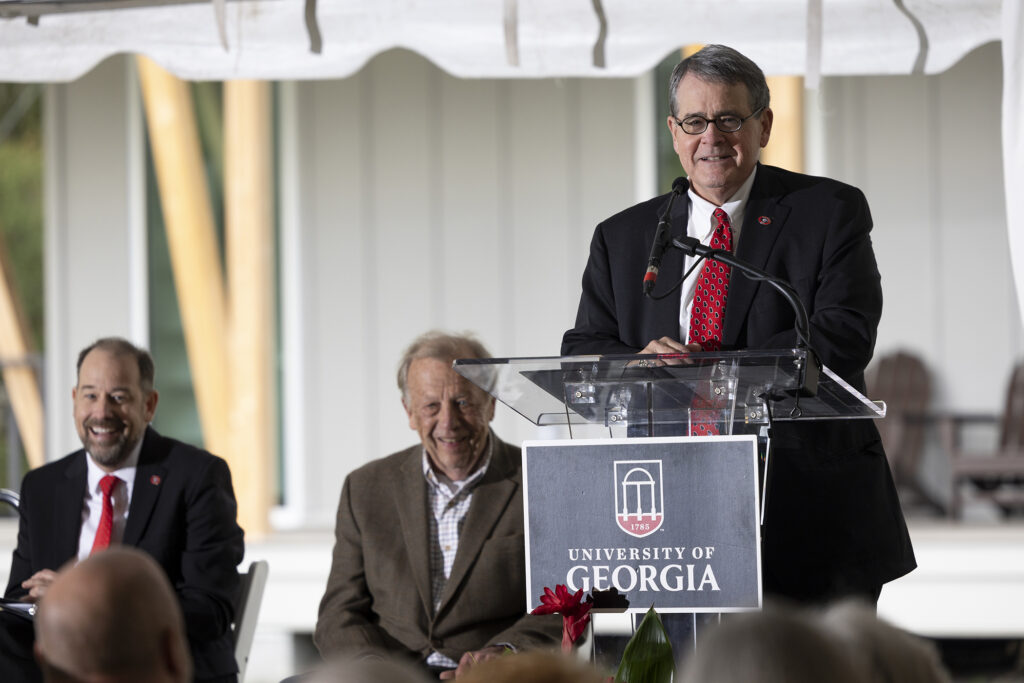For more than a decade Wormsloe, a historic property on the Isle of Hope near Savannah, has served as an outdoor classroom and research site for University of Georgia students and faculty. With a ribbon-cutting ceremony on Feb. 2, UGA celebrated the opening of an indoor space to enhance instruction, research and outreach in this unique setting.
The new $1.8 million Experiential Learning Center will serve as a classroom, laboratory and gathering space at the Center for Research and Education at Wormsloe (CREW), where UGA faculty members and graduate students conduct research in archaeology, historic preservation, geology, landscape architecture and other fields at one of the most ecologically and historically significant sites along Georgia’s coast.
The history of the Wormsloe property predates the founding of the colony of Georgia, and its connection to the university dates back nearly a century. Noble Jones, one of the state’s earliest settlers, established Wormsloe as a guard post to defend Savannah against Spanish attack in the 1730s. Two hundred years later, Jones’ descendants first partnered with the University of Georgia Libraries in 1938 with the acquisition of the Wymberly Jones De Renne Georgia Library, a collection of more than 10,000 items dating back to the Colonial period that were formerly housed at the Wormsloe estate and now form the foundation of UGA’s nationally renowned Special Collections Libraries in Athens.
In the 1950s, Jones’ descendant Elfrida De Renne Barrow and her family established the Wormsloe Foundation to foster preservation and support research, and the foundation launched a 70-year effort of supporting the UGA Press in the publication of scholarly works on history and the environment.
In 2012, the foundation, which is now led by Jones’ descendant and UGA alumnus Craig Barrow and Craig’s wife, Diana, donated 15 acres of the Wormsloe estate to the University of Georgia. The new facility, located here, is in part a tribute to Craig’s sister, the late Laura Barrow McIntosh, who devoted much of her life to protecting the natural environment through advocacy and public service.

“We are deeply grateful to the Wormsloe Foundation and all of the generous donors who contributed to this project, which means so much to the university and to the Barrow and McIntosh families,” said UGA President Jere W. Morehead. “CREW and the new Experiential Learning Center represent the University of Georgia’s commitment to interdisciplinary studies, which are needed to address the complex issues facing our world, and our commitment to hands-on learning experiences that help our students succeed after graduation.”
The foundation also supports the Wormsloe Fellowship program, which recruits and funds graduate students performing field research at the historic site. Fellows have conducted projects aimed at protecting Georgia’s coastal ecology, tracing butterfly migration, restoring longleaf pine populations and rediscovering sustainable crop varieties, among others.
Keeli Michael Windham, who served as a Wormsloe Fellow while pursuing her master’s degree in landscape architecture, said she felt inspired from the moment she set foot on the property.
“Wormsloe is a landscape where history, nature and the environment are displayed and celebrated side by side, welcoming all who seek to learn more about its past, present and future,” said Windham, whose work at CREW included the design of a memorial garden to honor McIntosh and a master plan for the property’s future growth.
Toby Graham, associate provost and university librarian at UGA, oversees the Center for Research and Education at Wormsloe.
“Today, we’re grateful for this latest accomplishment in a long and productive relationship between UGA and Wormsloe — advancing a mutual commitment to discovery and to Georgia,” said Graham. “The research that takes place here matters to our state and Georgia’s coastal region and is conducted in a manner consistent with the imperative to be faithful stewards of the natural and historic character of Wormsloe.”
The state of Georgia acquired most of the Wormsloe property in 1973. This area, known as the Wormsloe State Historic Site, is managed by the Georgia Department of Natural Resources.
“We have a successful and unique partnership with the Georgia Department of Natural Resources, UGA and the Wormsloe Foundation that will ensure the future of Wormsloe as a very important and historic site,” Craig Barrow said. “The good news is that Wormsloe is a special and extremely valuable natural environment for all citizens to enjoy. Wormsloe is in stronger and better shape than it has ever been.”


